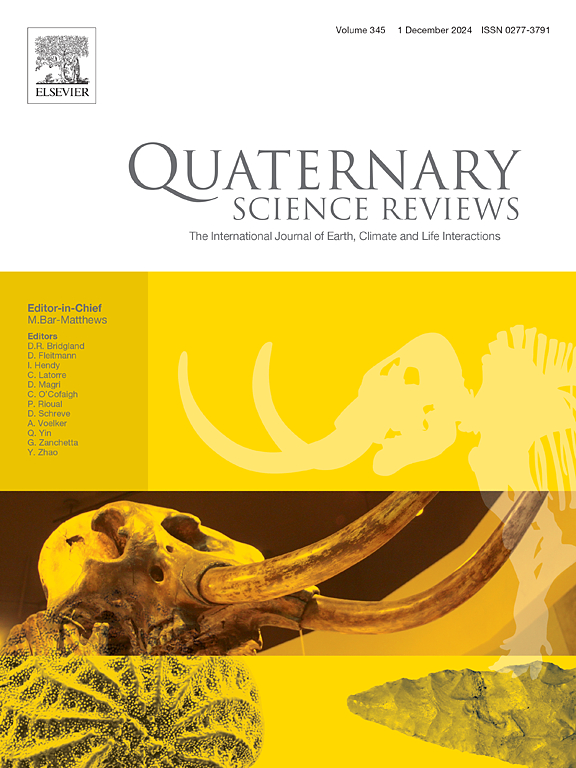Environmental variability of the last 1600 years derived from a multiproxy lake record of the east Andean margin (46.7°S), central west Patagonia, Chile
IF 3.3
1区 地球科学
Q1 GEOGRAPHY, PHYSICAL
引用次数: 0
Abstract
Central west Patagonia is directly exposed to influence of the Southern Westerly Winds (SWW). Its position relative to the core of this major wind system makes this region highly susceptible to magnitude and latitudinal changes of the SWW. Moreover, the pronounced topography defines a strong west-east moisture gradient. We present an environmental reconstruction derived from sediments of Laguna Vogt, a lake located in one of the easternmost valleys of central west Patagonia.
Our reconstruction shows that increased runoff triggered the remobilization of basaltic material, while lacustrine production remained low between 1600-1300 and 1000-750 cal yr BP. Between 1300-1000 and 750-250 cal yr BP, these conditions changed to decreased surface runoff, with less clastic input favoring high autochthonous sedimentation, while several episodes of flooding occurred.
Our findings indicate that intervals of enhanced runoff at Laguna Vogt correlate with a regional period of increased precipitation, which started to decline around 800 cal yr BP. Climate reconstructions suggest that increased precipitation was a direct result of intensified SWW. Thus, periods of high lacustrine productivity interspersed with episodes of intense flooding are interpreted as shifts between wet-cold and dry-warm conditions occurring on decadal to multidecadal timescales.
Around 250 cal yr BP, fluvial detrital input into the lake became dominant, suggesting the establishment of wetter conditions. This increase in precipitation, also documented by other sediment records from central west Patagonia, is associated with intensified SWW. Such a timing compares well with multiple regional glacial advances, indicating an environmental shift likely associated to the last glacial stage of the Holocene.
来自智利巴塔哥尼亚中西部安第斯山脉东部边缘(46.7°S)多代湖泊记录的近1600年环境变率
巴塔哥尼亚中部西部直接受到南西风的影响。其相对于该主要风系统核心的位置使该地区极易受到西南偏西强度和纬度变化的影响。此外,明显的地形决定了强烈的西-东水汽梯度。我们提出了一个来自拉古纳沃格特湖沉积物的环境重建,该湖位于巴塔哥尼亚中西部最东部的山谷之一。我们的重建表明,径流的增加触发了玄武岩物质的再活化,而湖泊的产量在1600-1300和1000-750 cal yr BP之间仍然很低。在1300-1000和750-250 cal yr BP之间,这些条件转变为地表径流减少,碎屑输入较少,有利于高原生沉积,同时发生了几次洪水。我们的研究结果表明,拉古纳沃格特径流增加的间隔与降水增加的区域周期相关,而降水增加的区域周期在800 cal yr BP左右开始下降。气候重建表明,降水增加是西南偏南加剧的直接结果。因此,湖泊生产力高的时期穿插着强烈的洪水事件,被解释为在十年到几十年的时间尺度上发生的湿冷和干暖条件之间的转变。大约250 cal yr BP左右,河流碎屑进入湖泊成为主导,表明形成了更湿润的条件。巴塔哥尼亚中西部的其他沉积物记录也记录了降水的增加,这与西南偏南的加剧有关。这样的时间与多个区域冰川推进相比较,表明环境转变可能与全新世的最后一个冰川阶段有关。
本文章由计算机程序翻译,如有差异,请以英文原文为准。
求助全文
约1分钟内获得全文
求助全文
来源期刊

Quaternary Science Reviews
地学-地球科学综合
CiteScore
7.50
自引率
15.00%
发文量
388
审稿时长
3 months
期刊介绍:
Quaternary Science Reviews caters for all aspects of Quaternary science, and includes, for example, geology, geomorphology, geography, archaeology, soil science, palaeobotany, palaeontology, palaeoclimatology and the full range of applicable dating methods. The dividing line between what constitutes the review paper and one which contains new original data is not easy to establish, so QSR also publishes papers with new data especially if these perform a review function. All the Quaternary sciences are changing rapidly and subject to re-evaluation as the pace of discovery quickens; thus the diverse but comprehensive role of Quaternary Science Reviews keeps readers abreast of the wider issues relating to new developments in the field.
 求助内容:
求助内容: 应助结果提醒方式:
应助结果提醒方式:


